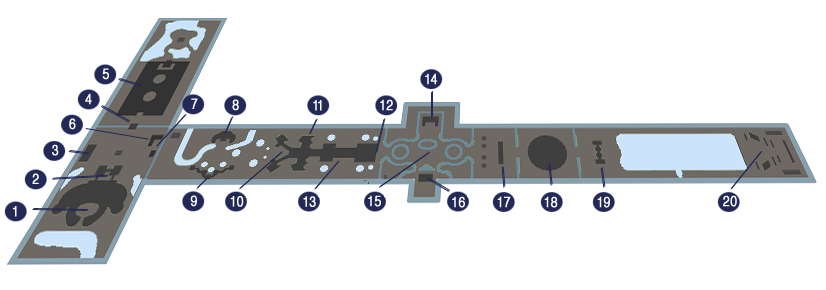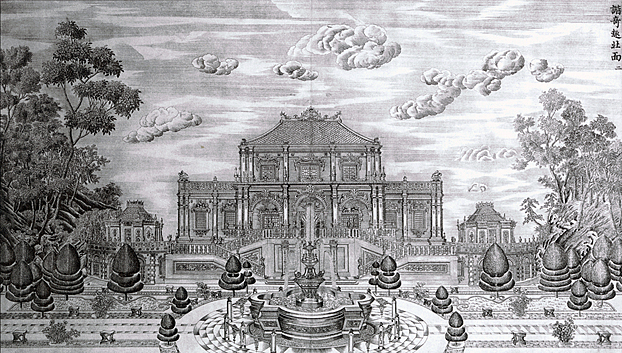 |
| |
A set of 18th-century engravings by Chinese court artist Yi Lantai documents the European-inspired section of Yuanmingyuan—here, the northern side of the Xieqiqu, one of the main palaces.
[ymy2002]
As seen in Part 1 of “The Garden of Perfect Brightness,” by far the greatest part of the private imperial enclave known as the Yuanmingyuan (圓明園) was comprised of Chinese-style landscapes and buildings. Between 1747 and 1783, however, the Qianlong emperor also called on the architectural and scientific talents of his Jesuit advisors to assist in constructing a number of European-style palaces, pavilions, and gardens in a section of this sprawling complex that covered about 20 acres.
Our ability to visualize this remarkable expression of Chinese “Occidentalism” today rests almost entirely on a suite of 20 copperplate engravings commissioned by the emperor in 1783, based on drawings by a Chinese court artist clearly influenced by Western pictorial conventions. These “20 Views” are reproduced here in Part 2. When Anglo-French forces plundered and destroyed the Yuanmingyuan in 1860, they did not spare the foreign section. Unlike the wooden structures in the Chinese gardens, the ruins of some of these stone and marble structures survived over the decades that followed, leaving many observers with the impression that the European-style buildings comprised the heart of the Yuanmingyuan. They did not, but both their indulgent splendor and their ruination tell us a great deal about the rarefied aestheticism and bitter tragedy of the last imperial Chinese dynasty.
Part 3 of “The Garden of Perfect Brightness” addresses the destruction of 1860, the massive looting and “collecting” that the British and French engaged in, and the place of the Yuanmingyuan in Chinese popular memory today.
|
|
| |
IMPERIAL OCCIDENTALISM
Beginning in 1709, the Qing emperor Kangxi (r. 1662 to 1722) began the construction of a garden retreat known as the Yuanmingyuan, or Garden of Perfect Brightness. His son, the Yongzheng emperor (r. 1723 to 1735) and grandson, the Qianlong emperor (r. 1736 to 1795) elaborately developed the garden and its buildings, and built two additional sections, which succeeding emperors continued to embellish. In 1747 Qianlong began to add a section of European-style buildings and gardens (the Xiyanglou) to the Eternal Spring Garden. Construction continued until 1783, totaling about 20 acres on a narrow strip of land.
|
|
| |
An artistic rendering of the Yuanmingyuan in the Qing period. The location of the European-style palaces (Xiyanglou) is indicated by a red outline.
|
|
| |
When Qianlong first expressed interest in having European-style fountains and buildings, which he had seen in drawings of European palaces, he turned to an extraordinary group of Jesuit advisors, whose expertise as artists and scientists
he greatly valued. Michel Benoit (1715-1774, arrived China 1744), trained in mathematics and hydraulics, designed the fountains—Qianlong’s first ambition. Court painter Giuseppe Castiglione (1688-1766, Chinese name Lang Shining, arrived China 1715), who had undertaken many imperial portraits and landscapes, was responsible for the design of the palaces themselves. He drew several pictures of Italian villas and French palaces and fountains, consulting books that the Jesuits had in their library. Other Jesuits such as Jean-Denis Attiret (1702-1768), discussed in Part 1, advised on various aspects of the palaces, including the interiors and the gardens that were built to complement the fountains. For years they worked of these projects, regardless of “the heat, the rain, the wind, and the blazing sun of the dog days.” The emperor was deeply involved, visiting the Jesuits almost daily. 1
Many Chinese architects and artisans participated in the construction. The chief architect to the imperial family was surnamed Lei, and his descendants continued for generations to serve the successive emperors. They were known as “Yangshi Lei,” roughly “Architects Lei.” They executed all the plans for the European palaces and gardens as well as the Chinese sections of the Yuanmingyuan. Chinese elements introduced by them or suggested by the emperor himself included Chinese–style hipped roofs with tiles and dragon and other animal designs.
|
|
 |
| |
The European Palaces (Xiyanglou) 西洋樓
Views 1 & 2: Pavilion
Harmonizing
Surprise
and Delight (Xiequ) 諧奇趣
View 3: Reservoir (Xushuilou) 蓄水樓
View 4: Gate to
the Garden
(Huayuanmen) 花園門
View 5: Garden (Huayuan) 花園,
also called Maze (Migong) 迷宮
Views 6 & 7: Aviary
(Yangquelong) 養雀籠
View 8: Observatory
of Lands Beyond
(Fangwaiguan) 方外觀
View 9: Bamboo Pavilion (Zhuting) 竹亭
Views 10, 11, 12, & 13: Hall of
Calm Seas
(Haiyantang) 海宴堂
|
View 14: Observatory of Distant Oceans (Yuanyingguan) 遠瀛觀
View 15: Grand Fountain
(Dashuifa)
大水法
View 16: Throne for
Observing the
Grand Fountain (Guanshuifa) 觀水法
View 17: Gate to
Perspective Hill
(Xianfashanmen) 線法山門
View 18: Perspective Hill
(Xianfashan)
線法山
View 19: East gate to Perspective Hill
(Xianfashan dongmen) 線法山 東門
View 20: Perspective paintings east of the lake (Hudong xianfahua) 湖東線法畫
|
|
| |
These European-style palaces and gardens were a testament to the extravagant tastes of the Qianlong emperor. In today’s language, we would say that everything was “over the top.” Contemporary Europeans dismissed the designs as “italo-gothico-chinois,” inferior for being not genuinely European. 2 The section was inspired by European designs of a Rococo or Baroque style that were already out of fashion in Europe itself. In the 1930s American scholar Carroll Brown Malone wrote:
The rococo architecture of these palace buildings recalls the extravagances of Italian art at the end of the 17th and the beginning of the 18th century… It is a style which differs almost as widely from present ideas of good architecture in the occident as it did from that of the Chinese buildings in the other parts of the Yuan Ming Yuan. Ch’ien Lung’s European palaces contained numerous false windows and doors, excessive ornamentation in carved stone, glazed tiles in startling color combinations, imitation shells and rock-work, meaningless pyramids, scrolls and foliage, and conspicuous outside staircases…But, in spite of obvious architectural faults, these buildings contained many a splendid view and many an exquisite detail. 3
A present-day art historian notes, “The final vision of a series of architectural tableaux bears little relation to any European garden. It was an entirely original arrangement of structures to form a theme park where printed and painted images of the West were translated into a three-dimensional reality.” 4 The European section of the Yuanmingyuan was perhaps the first theme-park in China, or worldwide, but only the emperor and his immediate court could play in it.
Collecting the West: the Emperors and Occidentalism
What did Western art and design mean to the emperors? The adoption of Western art styles or European-style palaces did not mean that the emperors intended to transform Chinese cultural conventions. After all, neither the portraits of the emperors in European costumes nor the 20 engravings (and the European palaces that they depicted) were intended for public viewing. All were commissioned or built entirely for the emperor’s pleasure and particularly his viewing pleasure. The buildings were never used as residences and their interior design remains unclear. Certainly they were filled with the thousands of European objects collected by the emperors. These included furniture and tapestries, clocks and mechanical toys, glassware and instruments. 5 The European palaces housed Qianlong’s vast collection of European objects given him by numerous hopeful priests and emissaries over the years. One was Father François Bourgeois, who wrote in 1786:
The European palaces contain only European ornaments and furniture. It is unbelievable how rich this sovereign is in curiosities and magnificent objects of all kinds from the occident. You ask me if the Emperor has any Venetian and French glass. Thirty years ago he already had so many pieces that, not knowing where to put them, he had a quantity of the first grade broken up to make window panes for his European buildings.
In the hall which he had made new for the tapestries of the manufacture of Gobelins, which the French court sent in 1767, there are many pier glasses. You see, this hall, 70 feet long and of good width proportionally, is so full of machines that one can hardly move about in it. Some of these machines have cost two or three hundred thousand francs, for the work on them is exquisite and they are enriched with innumerable precious stones. 6
Yet the palaces also housed numerous objects that were manufactured in China under imperial orders. They were examples of Occidentalism—the taste for European objects adapted to Chinese tastes.
The Kangxi emperor, who launched the Qing Occidental taste, had a substantial knowledge of his European monarchical counterparts, King Louis XIV (The Sun King, r. 1643 to 1715) and Peter the Great (r. 1682 to 1725), and was keen to learn about mathematics, science, and astronomy from the Jesuit missionaries. They in turn imparted to Europe the image of the Chinese monarch as an enlightened ruler. The French Jesuit missionary Joachim Bouvet (1656-1730) had considerable direct contact with Kangxi, and presented him with engravings depicting the Louvre and especially Versailles Palace, recently completed, with its gardens, fountains, and statues. Upon his return to France, Bouvet impressed upon Louis XIV the idea that the two monarchs greatly resembled each other in experience and outlook. 7
|
|
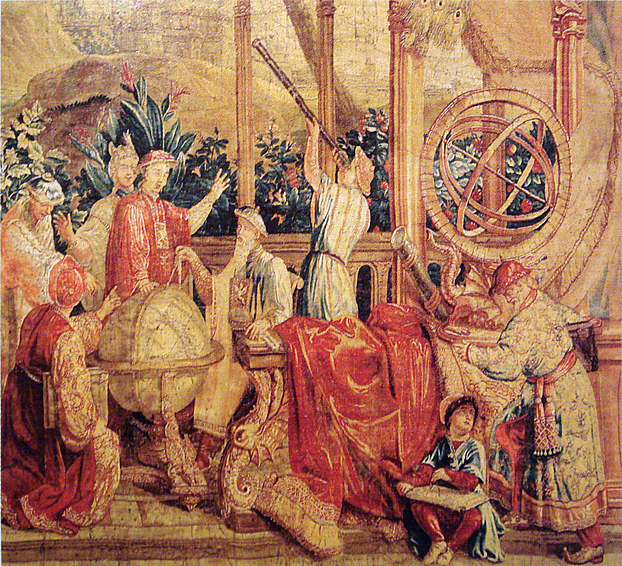 |
| |
This Beauvais tapestry shows the emperor and Chinese scholars with their Jesuit teachers and astronomical instruments.
“Les Astronomes,” Beauvais tapestry, 18th century.
[ymy8043] Wikimedia Commons
|
|
  In the Forbidden City and the Yuanmingyuan clocks, globes, compasses, telescopes, and other scientific instruments were collected in abundance. Some later reached European museums and collections after the Yuanmingyuan was sacked in 1860. Clocks were greatly valued by the court not just for the function of time keeping, but for their decorative possibilities. In the Forbidden City and the Yuanmingyuan clocks, globes, compasses, telescopes, and other scientific instruments were collected in abundance. Some later reached European museums and collections after the Yuanmingyuan was sacked in 1860. Clocks were greatly valued by the court not just for the function of time keeping, but for their decorative possibilities. |
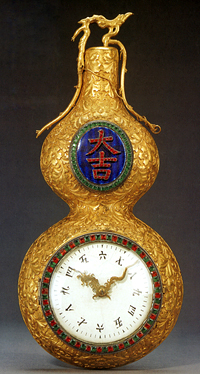 |
  This gilded, gourd-shaped Chinese-manufactured clock from the Qianlong era, with hands in the shape of a dragon and the inset characters “daji” (great fortune), was offered for sale at auction by Christie’s. This gilded, gourd-shaped Chinese-manufactured clock from the Qianlong era, with hands in the shape of a dragon and the inset characters “daji” (great fortune), was offered for sale at auction by Christie’s.
[ymy8022]
|
| |
After the European palaces were completed, they even served as the backdrop for some portraits. Prince Guo, for example, a half-brother of the Qianlong emperor, was painted in a familiar formal portrait with an unfamiliar background showing one of the classical archways in the European section (possibly the “Gate to Perspective Hill” in View 17). In Qianlong’s lifetime, the European pavilions did not fail “to perform their primary function for him: to provide a theatrical experience of the West that placed it firmly within the expanding global order of the Qing dynasty.” 8
|
|
| |
Occidentalism and the Qing Emperors |
|
| |
The Qing emperors’ Occidental taste and self-image also extended to portraiture. They were depicted in formal imperial portraits not only as scholars, warriors, and even Buddhist deities (as seen in Part 1), but also in European-style costumes and settings.
|
|
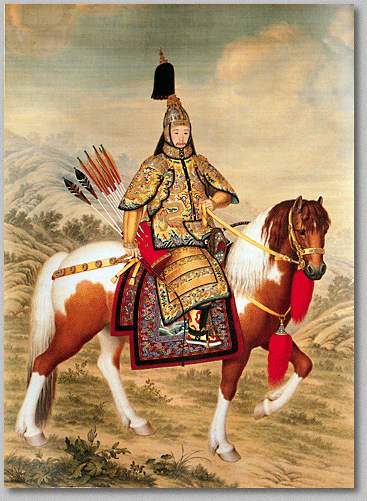 |
  This striking painting of “The Qianlong emperor in Ceremonial Armour on Horseback,” inspired by European equestrian portraits of monarchs and nobles, was painted in the mid-18th century by Giuseppe Castiglione, a Jesuit artist greatly esteemed by Qianlong. 10
This striking painting of “The Qianlong emperor in Ceremonial Armour on Horseback,” inspired by European equestrian portraits of monarchs and nobles, was painted in the mid-18th century by Giuseppe Castiglione, a Jesuit artist greatly esteemed by Qianlong. 10
“The Qianlong emperor in Ceremonial Armour on Horseback,”
Giuseppe Castiglione, 1739 or 1758
The Palace Museum, Beijing
[ymy3008] |
  This portrait of the Qianlong’s half-brother Hongyan, Prince Guo (1733-1765), takes one of the European-style gates at the Yuanmingyuan as its background. 11
This portrait of the Qianlong’s half-brother Hongyan, Prince Guo (1733-1765), takes one of the European-style gates at the Yuanmingyuan as its background. 11
Arthur M. Sackler Gallery,
Smithsonian Institution
[ymy3007]
| 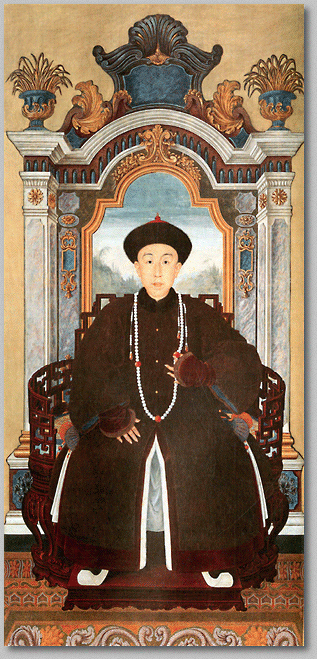
|
|



